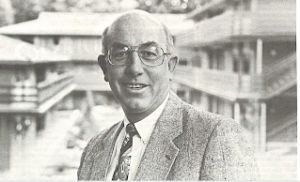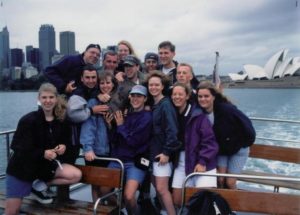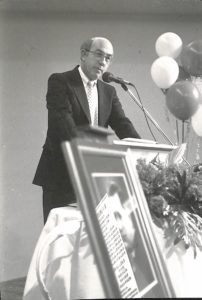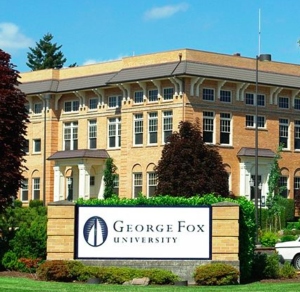The 1980s were a challenging time period for the college. By 1986, enrollment had dropped to 549 students and the college faced the prospect of significant debt due to the construction of Bauman Auditorium.

In 1982, David LeShana left the college and Edward Stevens became the new president. He came into the presidency with a background in business and development that the board hoped would allow him to stabilize and grow the college.
Edward Stevens was the first non-Quaker president of the college

New innovative programs inaugurated by the faculty in the 1980s included the degree completion program, which was aimed at assisting working adults to complete their undergraduate degree. At the time, Fox was one of only seven colleges in the nation to offer this type of program. In addition, the Center for Peace Learning was created in 1985 and the Juniors Abroad program in 1987.
For the first time in 1987, George Fox received recognition by U.S. News and World Reports as one of America’s Best Colleges. It ranked number 12 in the Midwest and Western Division. As the faculty grew as a result of increasing student numbers, there was a focus on attempting to hire a more diverse faculty. The unequal ratio of male to female faculty that had been evident since the 1960s began to slowly equalize.
In 1989, the college purchased its first graduate program: the clinical psychology program from Western Conservative Baptist Seminary. According to President Stevens, the addition of the PsyD program was the first step towards George Fox offering numerous graduate degrees. In 1992 the Master of Arts in teaching was created.
Additional Facts
- There was debate over whether to continue mandatory chapel as attendance was dropping.
- Wood-Mar Auditorium reopened after a significant remodel with the play “Big River”
- New rules were put in place for the Bruin Brawl after a freshman broke his ankle and hyper-extending his knee. Some students even argued the tradition should be discontinued.
- The administration announced that Brougher Hall would be torn down as the Edward-Holman Science Center was completed. Originally, Brougher was to have been torn down in the 1970s. As of 2024, the building was still in use.
- Academic Dean Dirk Barram filled in for President Ed Stevens while he was on sabbatical for six months.
In 1991, visiting hours were established for the first time, allowing students to visit opposite sex dorm rooms during certain hours.
The college celebrated its centennial in 1991 with plans for a campaign to raise $16 million, a campaign that eventually topped $25 million. That same year, George Fox College met a new enrollment record with 1,200 students.

In 1996, George Fox College entered a new era when it merged with Western Evangelical Seminary and became George Fox University. To some students and alumni, the word “university” implied a more relaxed social experience than the word “college”, which indicated the more rigorous educational experience for which George Fox was known. In the end it was agreed that George Fox would change its name, but would not change the strength of its academics. The Seminary, later renamed George Fox Evangelical Seminary (now Portland Seminary), experienced greater changes while not changing its essential nature.

After years of explosive growth, the university had come to a point where focus was needed for controlled growth and managing the ground that had been gained. When President Stevens passed away in 1998, it was apparent that the university needed time to regroup.